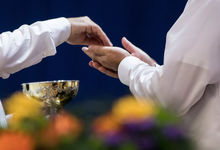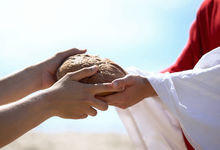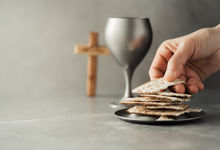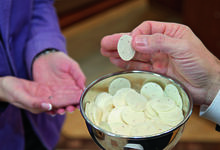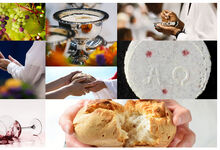The sacraments (38): Much more than just a receipt
When it comes to its understanding of Holy Communion, the New Apostolic Church is still fairly close to its Catholic Apostolic roots. But it has been quite a journey to get there. Following is an outline of the route.

A fellowship of table communities: the way in which a group of believers understands the sacrament of the altar is one of the fundamental elements that defines them as a church. It has been that way since at least the time of the Reformation in the sixteenth century. Above all, the question was (and remains): to what degree is the body and blood of Christ present in the bread and wine?
The Catholic Apostolic Church had some fairly conclusive answers. After all, it had access to theologians who were familiar with the technical vocabulary of the nineteenth century—and made use of it. By contrast, a new struggle for words can be observed with each author in the New Apostolic literature of the twentieth century. During the creation of the Catechism, which was published in 2012, the language and mode of expression abruptly returned to a level appropriate to the subject matter.
Symbol or reality?
The consistent answer to this central question always boils down to real presence. It was completely in the tradition of both Catholic and Lutheran doctrine that the Catholic Apostolic theologian Heinrich Thiersch wrote about “the true and real presence of the body and blood of Christ in Holy Communion”.
This thread winds its way through our Catechism: “Yet the bread and wine are not merely metaphors or symbols for the body and blood of Christ. Rather, the body and blood of Christ are truly present (real presence).”
Transformed or joined?
The doctrines of the ages are also largely in agreement on the question of how this real presence comes into being: the Catholic Doctrine of Transubstantiation (change) has been quite clearly rejected. The trend is moving more or less expressly in the direction of the Lutheran Doctrine of Consubstantiation (joining). In both cases, it is not the material structure of the bread and wine that change, but rather the content, the inner substance.
However, the textbook Questions and Answers made something of a detour at the beginning of the 1990s. Suddenly the term “spiritual reality” appeared in this context, a term which the Reformed churches usually use in opposition to the notion of real presence. However, this is less of a teaching change than merely an example of the difficulties that so often arise with the language.
Side-line or main event?
A completely different aspect shaped the understanding of the Lord’s Supper in the era of Chief Apostles Niehaus and Bischoff: where the forgiveness of sins had previously only served as a preparation for Holy Communion, the relationship was now reversed. The sacrament was now only considered something of a receipt for the absolution, which itself acquired a practically sacramental status.
The New Apostolic Church gradually distanced itself from this tradition. By the end of the 1960s, the textbooks had replaced the word “receipt” with the term “confirmation”. And from the start of the 1970s to the present, the view is that Holy Communion is the main event, and that the forgiveness of sins makes it possible for believers to partake of it worthily.
The key to understanding: dual nature
In the New Apostolic understanding of the Lord’s Supper, the aspect of sacrifice has shifted significantly from the Catholic to the Protestant position: the sacrifice of Jesus Christ is still present in Holy Communion, but there is no more mention of any response from the congregation. Up until the era of Chief Apostle Bischoff, this included the offering of the elements of bread and wine. The last trace of this notion—expressed in the words “das Dargebrachte [that which has been offered]” in the German consecration formula—disappeared with the liturgy reform of 2011.
With its catechism, the New Apostolic Church has not only revived, but also significantly expanded on, the earlier approaches of the Catholic Apostolic Church with respect to the Doctrine of Dual Natures. This concept is not only the key to understanding the nature of Jesus Christ, but also for explaining the nature of church, ministry, and sacrament.
Photo: wmedien - stock.adobe.com
Article info
Author:
Date:
Keywords:
Andreas Rother,
Reinhard Kiefer
20.07.2021
sacraments,
Holy Communion,
Doctrinal statements



